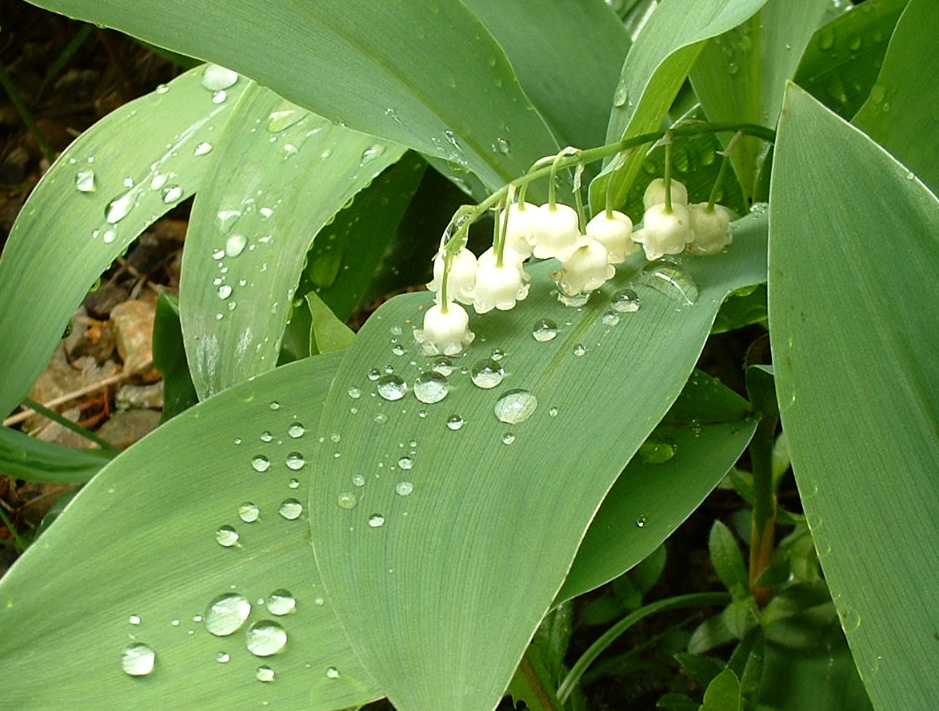Mystery
Perfumery has always glorified the floral and for centuries perfumers
have sought ways to extract the essence from real flowers to incorporate into
their creations. With many flowers this quest has met with considerable
success, with a few commercially viable products produced that are still used
in modern perfumery: rose and jasmine being the primary examples.
 |
| Lily of the Valley - picture courtesy of Wikimedia Commons |
One flower that has always eluded extraction is the Lily of the Valley (Convallaria majalis) or Muguet*: distillation yields very little of an
unpleasant smelling oil not a bit like the dense, exotic scent of the fresh
flowers. Solvent extraction and even modern CO2 extracts have similarly been completely unable to capture the
scent. This is because the flower
produces the scent only at the point of release – none is stored in the flower
– so it cannot be extracted. The
flower itself only contains pre-cursor chemicals from which the scent is formed
directly into the air.
 |
| Diorrissimo - picture from Basenotes |
Yet many people will be familiar with the scent of Lily of the Valley,
not through smelling the fresh flowers, but from perfumes containing or
replicating its scent – perhaps the most famous of these being Diorissimo. So, if you can’t extract the scent, how
is that done?
*Muguet is the French word for Lily of the Valley, a flower popularly used at weddings. Lily of the valley is a sweetly scented (and highly poisonous) woodland flowering plant that is native throughout the cool temperate Northern Hemisphere in Asia, Europe and in the southern Appalachian Mountains in the United States.
Manufacture
Here we see how the chemist is the perfumers best friend: a
good number of materials have been discovered or created that replicate, at
least in part, the scent of these mysterious flowers. Many people would say that synthetic Lily of the Valley
begins with the synthesis in the early part of the 20th Century of
Hydroxycitronellal: it’s difficult to be sure exactly when it was first used
because the nature of the material was kept a closely guarded secret. What we do know is that as early as
1906 it was being made by Givaudan and sold under the trade name Laurine.
At the outbreak of WWI it was being
manufactured in Germany and, as the war meant it ceased to be available,
efforts were made to find ways to make it that resulted in it’s being manufactured
in an American factory and, during the 20s, it gradually become well-known
within the trade. Most perfumers
would agree that, while no one chemical can ever fully represent the scent of a
flower, hydroxycitronellal gives a very close facsimile to the aroma of the
fresh flowers of Lily of the Valley.
Curiously enough however it does not appear to be present in that, or
any other natural flower scent.
 |
| Dr E Emmet Reid Credited with re-discovering Hydroxycitronellal Image from The Johns Hopkins University |
I’m presenting in the sections at the end of this post, descriptions of
a selection of materials that replicate the scent of Lilly of the Valley, with
descriptions of their olfactory properties as well as, in many cases, the
restrictions on their use that have led to their decline. These are mainly for the benefit of DIY
perfumers, but may also be of interest to perfumistas curious about
ingredients. I’ve included quite a
few quotations from Steffen Arctander’s wonderful descriptions of aroma chemicals –
rather less well known than his work on materials of natural origin – but just
as good.
Murder
 |
| Structure of Lyral - image courtesy Wikimedia Commons |
So where does the murder come in?
Well in one case a forthcoming ban by the European Union will, over the
next couple of years, result in the certain demise from perfumery altogether of
one of those materials. The
material that is being killed off by the regulators is Lyral and although it’s
only going to be banned in the EU, that will very likely be reflected in a
prohibition by IFRA (the International Fragrance Association) and even if it isn’t all the major perfume manufacturers
will phase it out of use completely, so it will effectively vanish from the
world.
After the jump you can read detailed descriptions of a range of materials used in connection with Lily of the Valley scents.
After the jump you can read detailed descriptions of a range of materials used in connection with Lily of the Valley scents.
